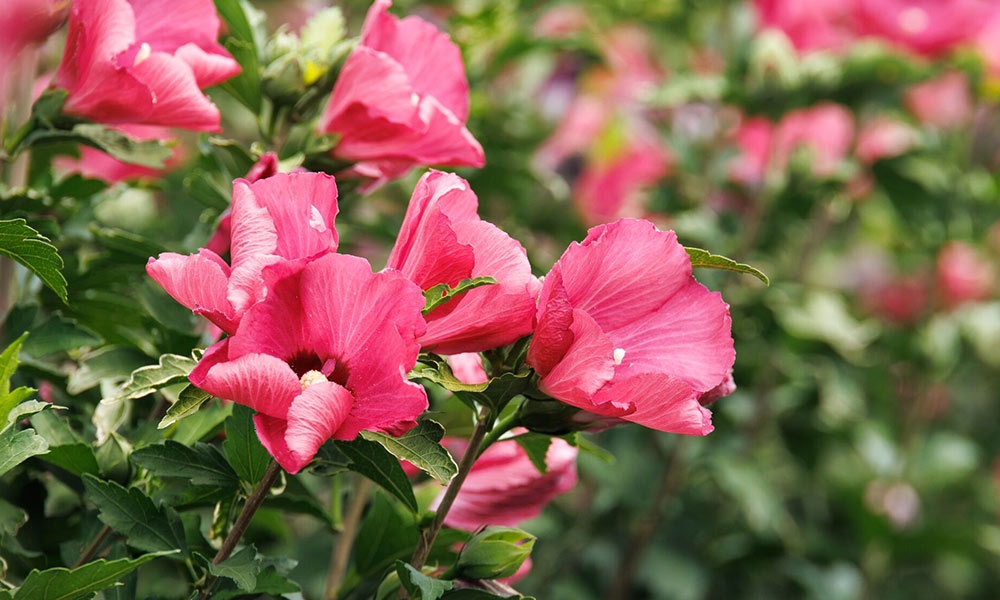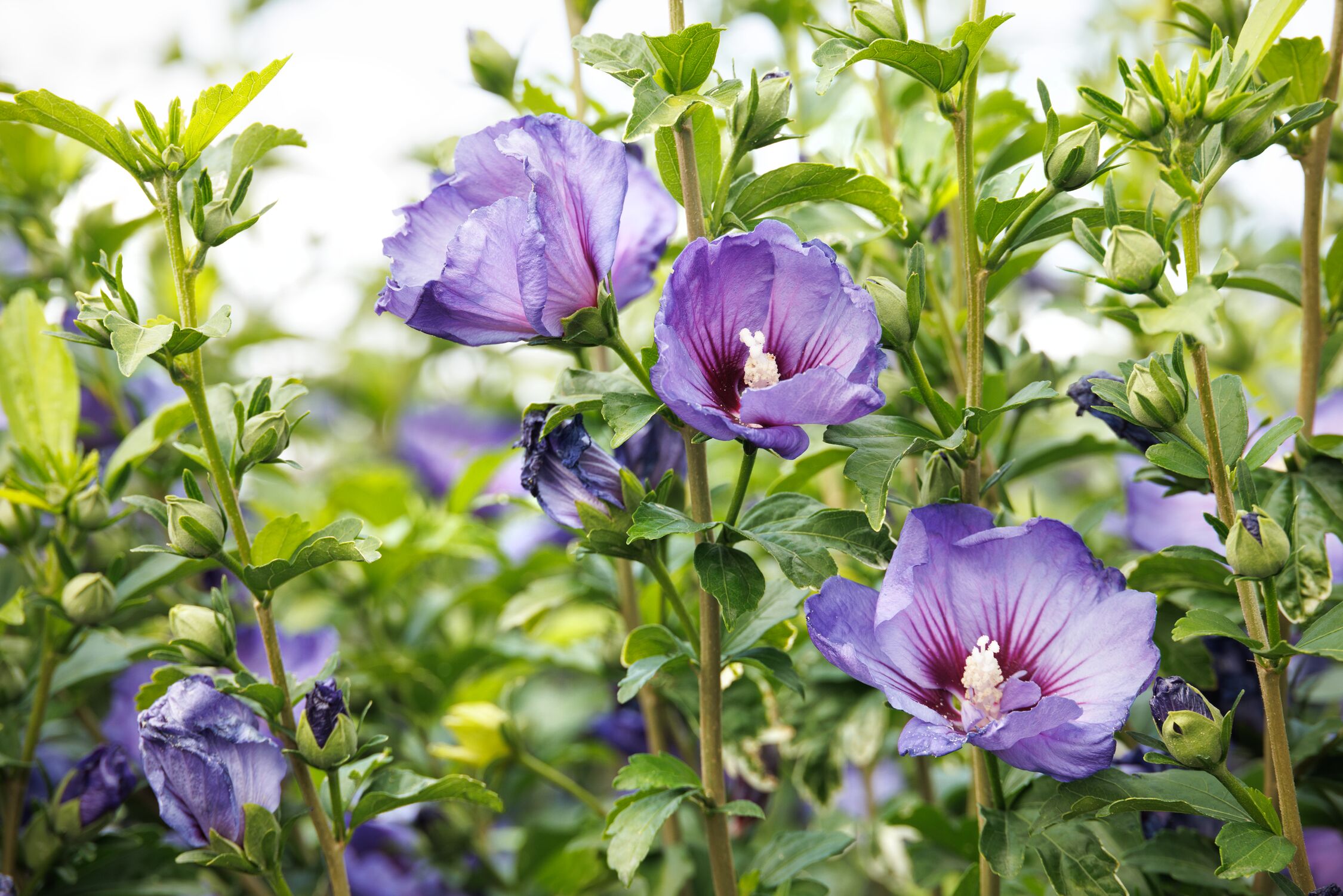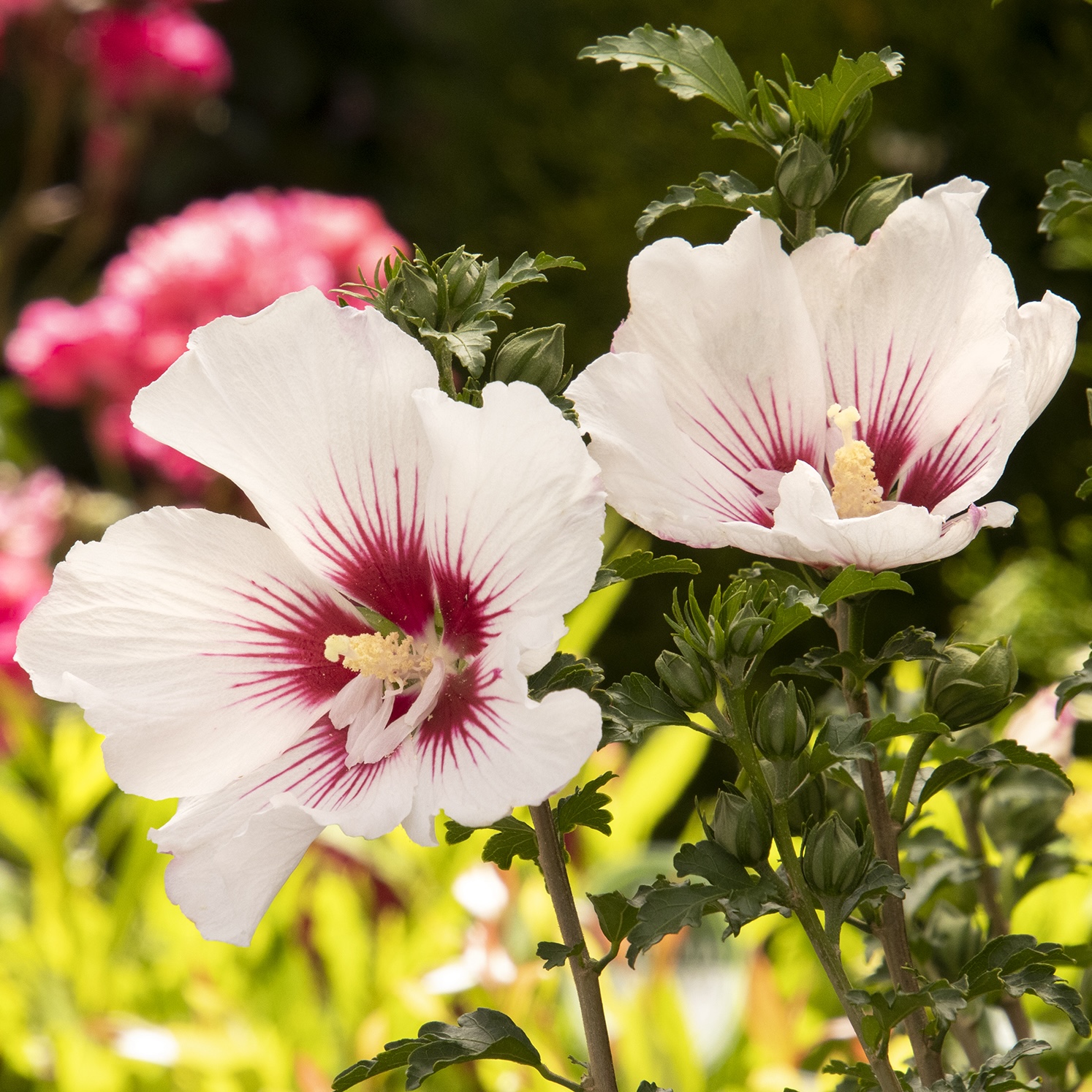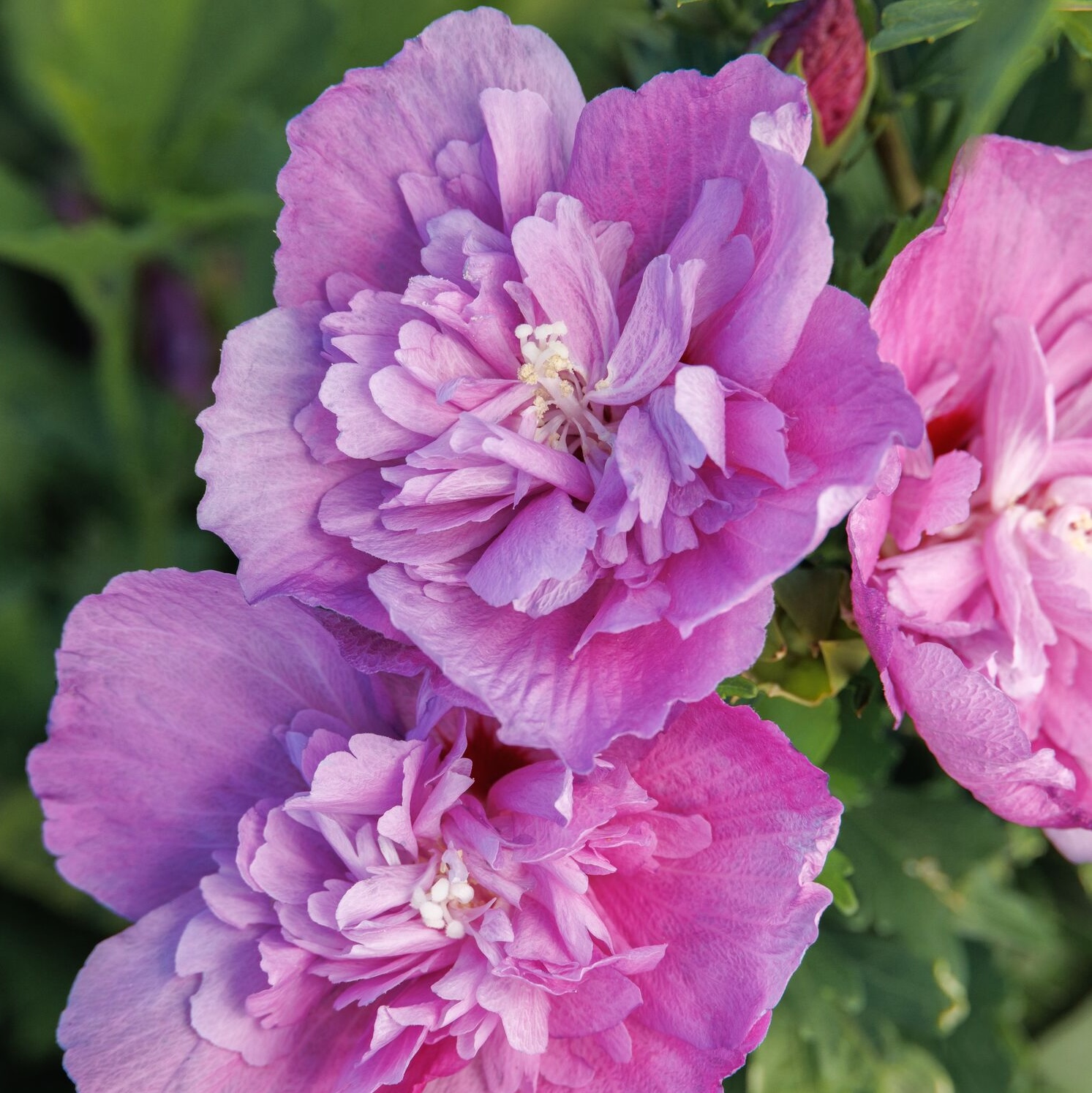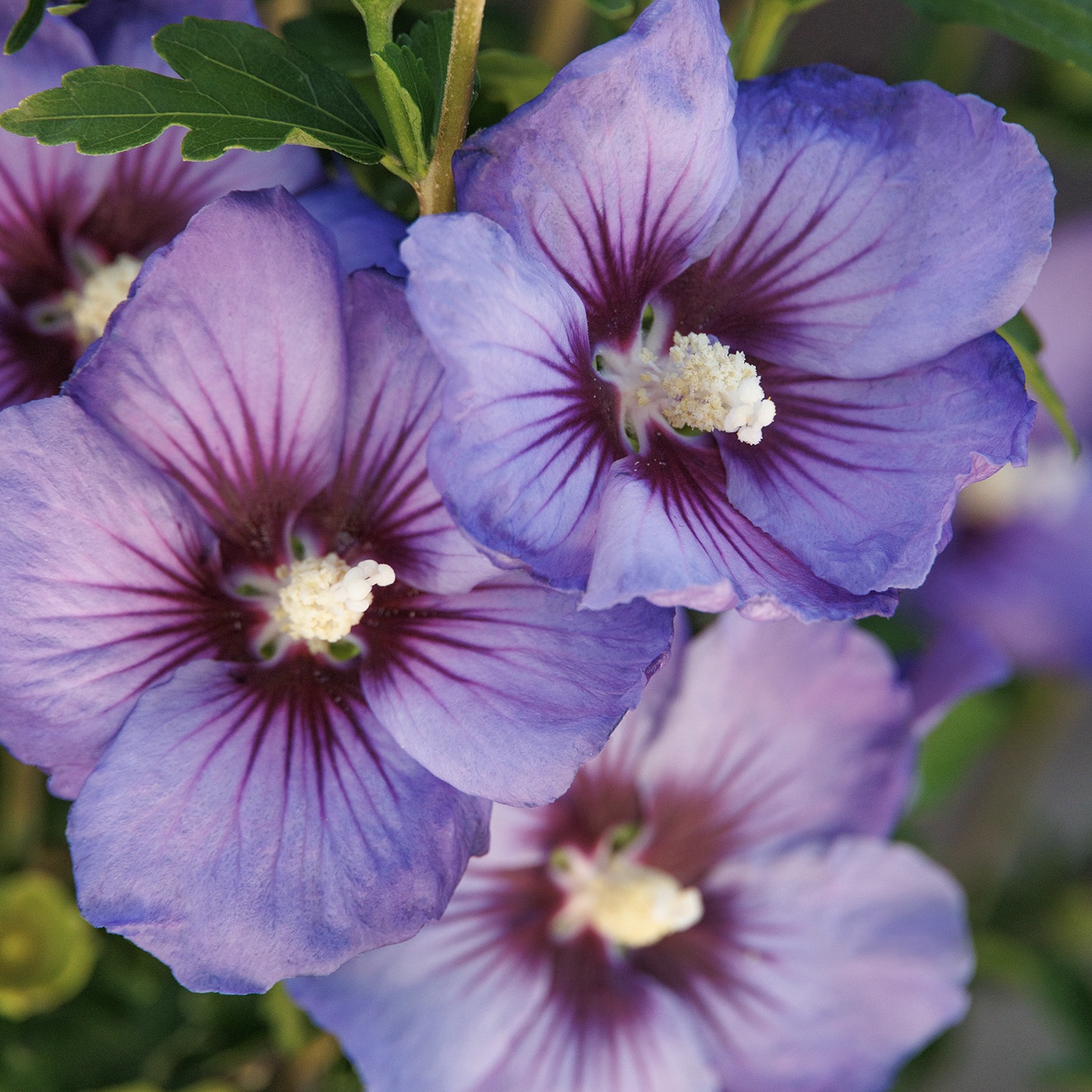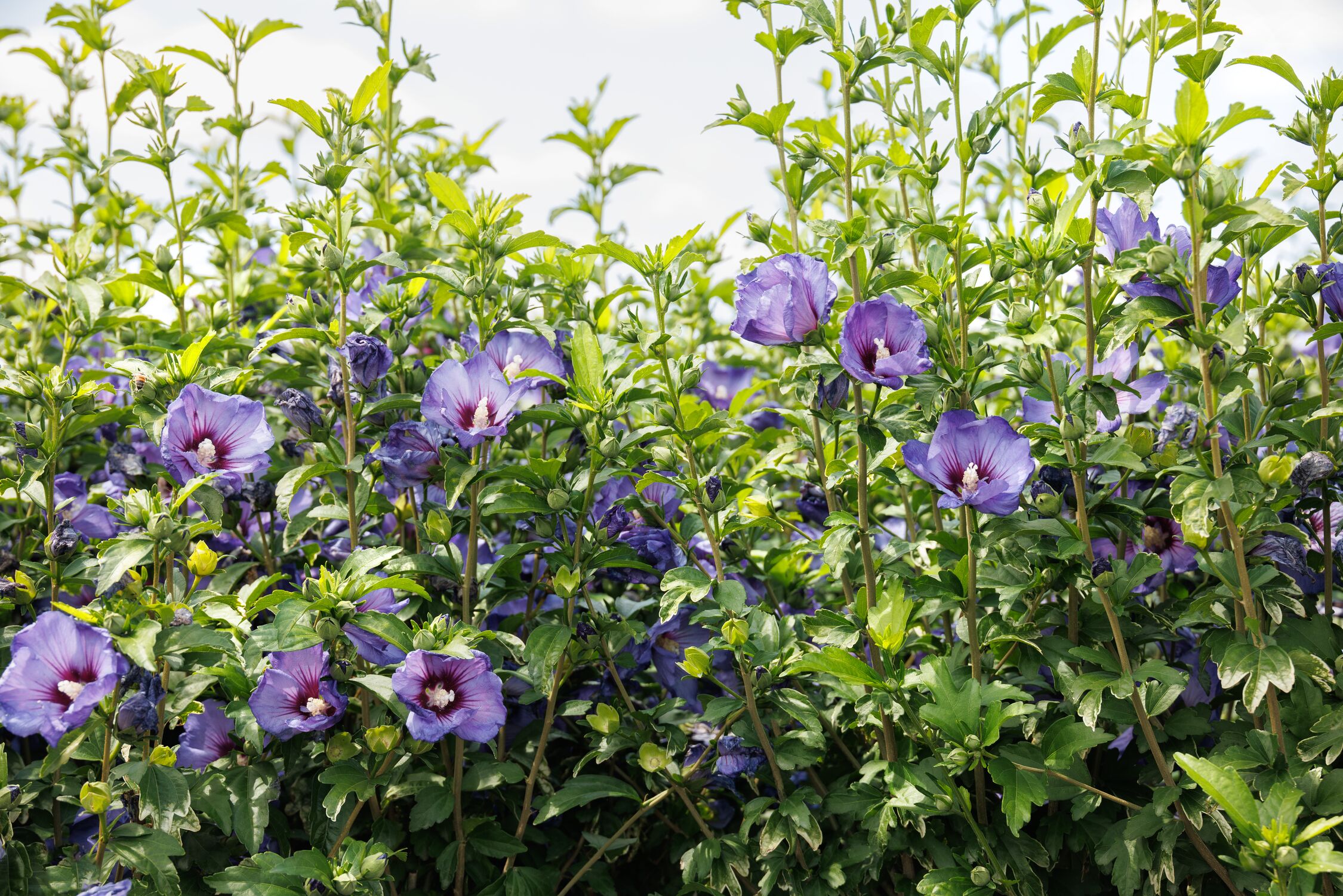Rose of Sharon (Hibiscus syriacus) is a stunning deciduous hibiscus species that brings beauty to any garden with its abundant blooms. These five-petal, paper-like flowers come in various colors, including bi-colors, and can reach up to 3" in diameter. They feature a prominent stamen and often a dark-colored throat.
Rose of Sharon is a low-maintenance flowering shrub that becomes drought and heat-tolerant as it matures, easily adapting to poor soil and urban conditions. With a natural upright vase shape, medium to dark green leaves, and the option to prune it into a tree form, this shrub offers versatility in the landscape. Whether you prefer single or double blooms or flat or frilly petals, there's a variety to suit every gardener's taste.
In the following sections, we'll walk you through the essential steps to successfully grow and maintain your Rose of Sharon, from planting to managing its growth. Start by selecting the superior varieties from Monrovia, and you'll be on the path to enjoying these delightful blooms for years to come. With proper care, your shrub can live up to 20 to 30 years, providing you with a long-lasting, low-maintenance addition to your garden.
Rose of Sharon Care: At A Glance
- Sunlight: Full sun preferred; tolerates light shade.
- Soil: Well-draining, nutrient-rich, slightly acidic to neutral pH. Rich soil is ideal for the fastest growth, but it will adapt to poor soils.
- Watering: Water regularly when young; drought-tolerant when mature. Avoid extremes.
- Fertilizing: Generally unnecessary; apply slow-release fertilizer or compost in spring if needed.
- Pruning: Prune in late winter or early spring; remove damaged/diseased branches and deadhead spent blooms.
- Potting: Use containers with proper drainage and well-draining potting mix; repot in spring or fall.
- Overwintering: Protect from strong, cold winds; apply mulch in colder regions.
- Pests: Control Japanese beetles by handpicking and dropping them in soapy water.
Types of Rose of Sharon: The Chateau™ Series
The Chateau™ series represents a significant improvement in Rose of Sharon breeding, developed by Monrovia in collaboration with a plant breeder. This new series offers several notable enhancements over traditional varieties, making it a standout choice for gardeners:
- Improved Flower Coverage: This series features blooms that cover the stems from top to bottom for a stunning display, rather than just having flowers at the ends of the stems.
- Vibrant Colors and Strong Stamens: The Chateau™ series showcases vibrant colors and prominent stamens, which add to the flowers' visual appeal.
- Multi-Stemmed, Upright Habit: Unlike some Rose of Sharon varieties that tend to sprawl, the Chateau™ series boasts a multi-stemmed, upright growth habit, creating a more structured and attractive appearance in the landscape.
- Extended Bloom Season: With a longer flowering period from early summer to fall (depending on your growing zone), the Chateau™ series provides a prolonged display of color in the garden.
- Size and Hardiness: These fast-growing shrubs thrive in zones 5-9 and reach an impressive 6 ft. tall and 4 ft. wide at maturity.
- Versatile Planting Options: These flowers are ideal for various garden settings, including full sun or partial shade. They can serve as a colorful backdrop for other shrubs or as a sensational specimen plant, adding height, scale, and a tropical look even in cooler climates.
The Chateau™ series is available in five captivating colors, offering gardeners a range of options to suit their landscape design preferences. Here are a few:
- Chateau™ de Chambord: Features large, showy, pink blooms with a deep red-violet center. This variety pairs beautifully with deep greens, such as boxwoods in formal gardens or panicle hydrangeas in cottage-style designs.
- Chateau™ de Versailles: Offers blue-violet flowers with a deep red-violet center, perfect for creating an ombre effect when combined with lavender, blue hydrangeas, and catmint.
- Chateau™ de Chantilly: Displays exquisite white blooms with a deep red-violet center, adding stately elegance to all-white gardens. Complement with white roses, salvia, and jasmine, or play on the center color with raspberry-toned monarda or coneflowers.
With its improved flower coverage, vibrant hues, attractive growth habit, and versatile color options, the Chateau™ series is a must-have for those seeking showy flowers and a tropical touch in their gardens, even in cooler climates.
Rose of Sharon Care
Caring for your Rose of Sharon is relatively easy, as this hardy shrub is tolerant of urban conditions, heat, humidity, poor soil, and drought. To ensure your plant thrives, follow these essential care guidelines:
Planting
- Plant Rose of Sharon in the spring or early fall, spacing them 6' to 10' apart.
- Choose a location with full sun and nutrient-rich, well-draining soil. This shrub is primarily used as a specimen, hedge, or foundation plant, making it a valuable addition to any landscape.
Root Ball Preparation
- Dig a hole as deep as the root ball and 2 times wider.
- Remove the plant gently from its nursery pot and loosen the soil around the root ball.
- Set the plant into the hole with the top of the root ball at soil level or slightly above.
- Backfill the hole with soil and tamp down slightly to remove air pockets. Water well.
- Mulch with a layer of shredded bark to retain moisture and suppress weeds. This shrub is primarily used as a specimen, hedge, or foundation plant, making it a valuable addition to any landscape.
Watering
- Young plants require regular watering and feeding to establish themselves.
- Mature shrubs only need watering during prolonged periods of drought.
- Avoid extremes: don't let the soil fully dry out or become waterlogged. Proper watering is crucial for the health and growth of your Rose of Sharon.
Pruning
- Prune regularly to maintain the desired shape of your shrub.
- Remove seedlings if you don't want more Rose of Sharon in your landscape, as they self-seed in some climates. Pruning helps control the size and shape of your plant while promoting healthy growth.
Light and Soil Requirements
- Rose of Sharon prefers full sun exposure, meaning at least 6 to 8 hours of direct sunlight on most days.
- It can also tolerate partial shade, although too much shade may reduce flowering and contribute to fungal diseases. This shrub grows best in nutrient-rich, well-draining soil with a slightly acidic to neutral pH, but it can also adapt to slightly alkaline soil and various soil types, including loamy, sandy, and clay soils.
Temperature, Humidity, and Fertilizer
- Rose of Sharon shrubs are heat lovers and can withstand winters with temperatures below -20°F.
- They also tolerate high humidity if provided with good air circulation to prevent fungal growth.
- While established shrubs don't necessarily require fertilizer unless the soil quality is poor, you can apply a slow-release fertilizer in the late winter or early spring, following label instructions. For an organic approach, work 1-2 inches of compost into the soil around the root zone in the spring.
By following these care guidelines, you'll be able to enjoy the beautiful blooms of your Rose of Sharon for many years to come. This versatile shrub will thrive in your landscape with proper care and attention.
Maintaining Your Rose of Sharon
Pruning
Rose of Sharon grows naturally in an attractive form, so it doesn't require extensive pruning. However, you can tidy up its growth each year to maintain the desired size and shape. Keep in mind that this shrub blooms on new wood, so it's best to prune it in the late winter or early spring to avoid cutting off any flower buds later in the season. Pruning back stem tips will encourage more branching and, consequently, more flowers. Remove any damaged or diseased branches as soon as they arise to keep your plant healthy and thriving.
In some climates, you might find that your Rose of Sharon is producing seedlings. If you're dealing with a self-seeding Rose of Sharon, you may find that it can become messy as it spreads seeds. To mitigate this issue, consider the following:
- Deadhead the seed pods as they develop to prevent unwanted spreading
- Remove any seedlings that sprout up in undesired locations
- Note that Rose of Sharon is considered invasive in Pennsylvania, Kentucky, Virginia, and Tennessee. In these areas, choose sterile cultivars that produce little to no viable seeds
Potting and Repotting
When potting or repotting your Rose of Sharon, it's crucial to do so when temperatures are warmer, ideally in the spring or fall. To ensure your plant has room to grow without being overwhelmed, follow these guidelines:
- Choose a pot that is one to three inches larger than your plant's current root system
- Opt for a container with drainage holes to prevent waterlogging
- Use a high-quality, well-draining potting mix
As your Rose of Sharon grows, you can either upgrade to a larger container or prune the roots to maintain its current size. Another option is to relocate your shrub into your landscape.
Overwintering
Rose of Sharon generally doesn't require any special winter care in its hardiness zones. However, to give your plant the best chance of thriving through the colder months, consider planting it in a spot that's protected from strong, chilling, and drying winds. If you live in a particularly cold part of its hardiness zones, adding a layer of mulch around the roots can help insulate the shrub from extreme weather conditions.
Common Pests
Japanese beetles are Rose of Sharon's primary pest problem. Fortunately, their large size makes them relatively easy to spot and control before they cause significant damage to your plant. To effectively eliminate Japanese beetles, simply pick or shake them off the plant by hand and drop them into a container filled with soapy water. The soap coating will suffocate the insects as they breathe through their skin.
Commonly Asked Questions about Rose of Sharon
How long does it take for Rose of Sharon to reach full size?
Rose of Sharon typically takes 4 to 10 years to reach its mature height of 8' to 12', depending on the variety and growing conditions. Regular pruning helps control its size and shape.
Is Rose of Sharon deer-resistant?
Rose of Sharon is generally considered deer-resistant due to its woody stems and thick leaves. However, deer may still nibble on the plant in certain situations. Planting with other deer-resistant shrubs and using repellents can help deter damage.
Can the Rose of Sharon be propagated easily?
Rose of Sharon can be easily propagated through 4" to 6" softwood cuttings taken in late spring or early summer. With proper care, roots should develop within 4 to 8 weeks.
Get More Plant Care Tips and Guides
- Sign up for the Grow Beautifully Newsletter. You'll get gardening tips, design ideas, free digital guides, and live webinar invites. Plus, new, exclusive plant information is delivered straight to your inbox twice a month.
- Shop all Rose of Sharon
- Rose of Sharon: The Chateau Series
- Our Top 10 Gardening Tips
- Guide to Pruning Flowering Shrubs
- Find the Best Plants for Your Garden
- Inspiring Garden Ideas
- Check out the "Garden Tips" section of the blog. Here, you can find care guides and garden tips on various plants.




